|
|
||||
Elon is scratching for a reason to keep worrying about CO2In the interview with Donald Trump, Elon Musk tried to argue that we ought be limiting carbon dioxide because we are too close to 1,000ppm where people get headaches. Not to put too fine a point on it, but we breath out air at 40,000 ppm fifteen times a minute for our entire lives. If 1,000 ppm gave us a headache or made us nauseous, we’d have to hold our breath every time we kissed someone. @ElonMusk: The point I was making is that, even if CO2 did not cause global warming, it is uncomfortable to breathe air with >1000 ppm of CO2. Given that the outdoor ppm away from cities is now ~420 (lol), it is already getting close to 1000 ppm indoors in cities at times. You can buy a cheap CO2 monitor and measure this for yourself. As the global base level of CO2 keeps increasing, it will cause air quality in cities to feel stuffy and unpleasant, resulting in drowsiness, poor concentration and eventually headaches and nausea. That would not be a good future. And then he quotes CO2meter.com which, ahem, sells CO2 meters, and has an incentive to wildly overstate the problems with CO2, which they do. CO2 is not the problem, the stale air and other pollutants cause headaches and sleepinessThe point of CO2 meters is not so much to warn us about excessive CO2 levels, but to indicate how well the room is ventilated. CO2 levels are just an indicator for air quality. Air with higher CO2 levels usually also has higher levels of organic compounds, humidity, body odour, mold, chemicals from furniture and paint (like formaldehyde) and potentially viruses too. When people report headaches and nausea, the high CO2 levels are not the issue, it’s the bioeffluence that causes problems. When researchers do cognitive tests with pure CO2 added to clean air, performances don’t suffer. The stale air is the problem, not the CO2. (See Zhang, and Misra where they compared the cognitive effects from badly ventilated air and clean air with high CO2 levels up to 3,000ppm. Problems disappear when they use fresh air plus higher CO2.) Well ventilated rooms may also be cooler rooms, which might explain why results so often contradict each other. Classrooms are at 1,000ppm “typically”While outdoor air is 420ppm, indoor levels of CO2 are commonly 1,000ppm in classrooms every day, and can rise as high as 3,000ppm if all the windows are shut. The recognized occupational health and safety levels for long term working exposure are 5,000 ppm for 8 hours straight, five days a week. It’s no big deal. The National Collaborative Centre for Environmental Health (Canada) measured school and buildings and advises that “Typically, in an occupied classroom situation, the recommended level of ventilation would correspond to a CO2 level of approximately 1000-1100 ppm“. Furthermore, they said the “lowest level at which a human health effect (i.e. acidosis) has been observed in humans is 7,000 ppm, and that only after several weeks of continuous exposure in a submarine environment”. The occupational limits for CO2recommended by the American Conference of Governmental Industrial Hygienists (ACGIH) are 5000 ppm (TLV-TWA) and 30,000 ppm (TLV-STEL), based on the direct effects on acidification of the blood. — via Marc Morano and Climate Depot At NASA The Office of the Chief Health and Medicial Officer reports that a typical spacecraft works at around 3,000-7,000 ppm (or o.3-0.7% CO2). The recommended exposure is 5,000, and the permissible exposure limit is 10,000 ppm. Although the flight surgeons found levels of nearly 7,000 were safe and “didn’t affect performance”. On Apollo 13, CO2 levels rose to 20,000ppm. Sweating and shortness of breath became a problem above 30,000 ppm. Submariners typically live with CO2 levels of 2,000- 5,000 ppm, and when a small sample of sailors was tested at 600, 2500 or 15,000 ppm, the researchers couldn’t find any difference in results from an 80 minute test on decision making. (Rodeheffer at al) Likewise another study at the Johnson Space Centre, people did cognition tests at 600, 1,200, 2,500 and 5,000ppm and there was no dose response effect. Results look rather random. Lowther et al looked at 51 studies in 2021, and found nothing conclusive in terms of harms from CO2 below 5,000ppm. Most studies were confounded, results were conflicting. Teams of researchers are hunting to find another problem “due to CO2”. If there was a strong negative effect of CO2 it would have shown up by now. Instead CO2 is only associated with occasional headaches and nausea — probably because it is high in crowded rooms with little ventilation. One large review in 2019 was described as showing CO2 affected people at levels as low as 1,000ppm, but the paper itself points at the confounding data and uses the words “possible” and “potential effects” and concludes “we need more studies.” UPDATE: Commenters Alan Klein and Mr Farnham points out the safety limits for Australian coal miners (NSW) is 1.25% CO2 which is 12,500ppm, and that is for 8 hour shifts. Brief excursions up to 3% (30,000ppm) are acceptable. See comment #17 for more details. REFERENCESLowther, Scott D., Sani Dimitroulopoulou, Kerry Foxall, Clive Shrubsole, Emily Cheek, Britta Gadeberg, and Ovnair Sepai. 2021. “Low Level Carbon Dioxide Indoors—A Pollution Indicator or a Pollutant? A Health-Based Perspective” Environments 8, no. 11: 125. https://doi.org/10.3390/environments8110125 Mishra AK, Schiavon S, Wargocki P, Tham KW. Respiratory performance of humans exposed to moderate levels of carbon dioxide. Indoor Air. 2021 Sep;31(5):1540-1552. doi: 10.1111/ina.12823. Epub 2021 May 15. PMID: 33991134. Rodeheffer CD, Chabal S, Clarke JM, Fothergill DM. Acute Exposure to Low-to-Moderate Carbon Dioxide Levels and Submariner Decision Making. Aerosp Zhang X, Wargocki P, Lian Z, Thyregod C. Effects of exposure to carbon dioxide and bioeffluents on perceived air quality, self-assessed acute health symptoms, and cognitive performance. Indoor Air. 2017 Jan;27(1):47-64. doi: 10.1111/ina.12284. Epub 2016 Mar 7. PMID: 26825447. h/t to Willie Soon, Marc Morano and Climate Depot. Photo: NASA/Mark T. Vande Hei (taking some images of the Russian modules) Jan 2022
By Jo Nova It’s something to be proud of: Russia, Australia and USA have the biggest Greenhouse Gas Export footprint on Earth. It’s a bizarrely contrived title though, where we have to ignore domestic emissions and blame countries instead for the fuels they dig up which someone else uses. (You know they want to). We could play this game in so many ways. If China uses Australian coal to make a fridge, do those emissions belong to Australia, or China or to the Norwegian who bought the fridge? Correct answer: “all three”. The game of emissions mobile-blame means the shame can be applied to whichever patsy is the most useful. Double counting is not a mistake, it’s a marketing tool. In a normal world, no one is responsible for what someone does with goods they sold, but in green economics, comrade, it all belongs to the Party. You are supposed to badger and harass the people you sold the goods to, to ask them not to use it: [Dr Gillian Moon] said if Australia was serious about its climate commitments, it should be doing more to encourage countries that bought its fossil fuels – particularly the developed economies Japan, South Korea and Taiwan that take about two-thirds of its exports – to move more rapidly to renewable energy. She said it should be having similar discussions with like-minded fossil fuel exporters, such as Canada and Norway. (From The Guardian, linked below). What this graph really shows is who is the Great Global Patsy — not Russia, because they are not working directly against their own economic interest, but Australia — the nation which stands to lose the most money per capita due to the demonization of fossil fuels, and which aids and abets the carbon-hate all the way, and never spends a cent to audit the UN Committee. This one-sided study was, of course, done in Australia. It was put together by the UNSW “Human Rights” Institute which spent exactly no minutes thinking about the human rights of poor people who want to be warm and buy our coal. Nor did they consider the starving kids of Haiti who benefit from cheaper food grown in a world with bountiful CO2. The US has larger fossil fuel exports than Australia, but we export more coal, which is a more “emissions intensive fuel”, they say, so we export more emissions. (They should pay us for the coal, the oil, the gas, the fertilizer, and the warmer weather). Source:Climate Analytics
Australian fossil fuel exports ranked second only to Russia for climate damage with ‘no plan’ for reductionAdam Morton, The Guardian Australia’s coal and gas exports cause more climate damage than those from any other country bar Russia, according to a new study that argues the country is undermining a global agreement to transition away from fossil fuels. The analysis, commissioned by the University of New South Wales’ Australian Human Rights Institute, found Australia was the third biggest fossil fuel exporter on an energy basis in 2021, trailing only Russia and the US. See also The Conversion:* Dug up in Australia, burned around the world – exporting fossil fuels undermines climate targetsAustralia mainly exports fossil fuels to Japan, China, South Korea and India. These countries, which accounted for about 43% of fossil fuel CO₂ emissions in 2022, are also signatories to the Paris Agreement. So they have set 2030 emissions reduction targets and net-zero goals of their own. Continuing to import fossil fuels is incompatible with their own commitments.
*It is hardly a Conversation while they ban skeptical opinions, eh?
Hiding the costs of renewables until after the next electionThe largest coal plant in Australia was supposed to close in August next year, but the NSW government decided to buy a two year extension until a few months after the next state election. Now the modeling comes out showing that they decided to keep the Eraring coal plant running to prevent the shocking price spikes from disturbing the voters. Keeping the coal plant will reduce wholesale electricity bills by a few billion dollars. (Why don’t we keep it open for ten years?) Presumably his reelection chances would be worse if “saved the planet”, and shut the coal plant a few months before the election instead. They know the voters don’t want the transition. They know it will cost more. And yet they do it anyway… Bizarrely, this news comes from the renewable industry site Reneweconomy, where Giles Parkinson doesn’t seem to notice this shows coal power is cheap and renewables are hideous. Apparently he doesn’t mind inflicting costs on hapless homeowners, he is just bummed that they couldn’t force more unreliable energy and battery packs on the grid even sooner: NSW confirms Eraring closure delay driven by fear of pre-election price shocksThe NSW state Labor government has confirmed that its controversial decision to delay the closure of the country’s biggest coal fired power generator at Eraring was primarily driven by concerns over a possible jump in wholesale electricity prices. The 2.88 gigawatt (GW) Eraring facility on the central coast was due to close on August, 2025, but under an underwriting deal with the state government which could be worth up to $450 million, Origin Energy will now keep at least two units open until August, 2027, a few months after the next state election. Delaying the closure of Eraring even longer until 2028 could save $4.4 billion: Modelling that the Minns government relied upon – produced by Endgame Economics and ICA Partners – has now been released (or at least bits of it) – and confirms that the greatest benefit of the delayed closure would come from lower prices. A summary of the Endgame analysis tabled in parliament on Tuesday suggests that the savings on wholesale market prices would total $4.4 billion, with a relatively small benefit of $300 million allocated to increased energy security and $200 million for avoided system strength measures. The report says this would outweigh the $1.1 billion negative benefits from higher emissions resulting from the burning of more coal, and other costs of $600 million, including $400 million in payments to Origin. Overall, it puts the net benefits at $3.2 billion to $3.5 billion. More bizarrely, Giles Parkinson argues that the futures market is predicting even higher prices than the modelers are: He views this train-wreck as a bad situation caused by Big Market Players exploiting the market, and they absolutely are. But he doesn’t admit that if we weren’t trying to ram a fake transition down everyone’s circuits with unreliable generators, the Predators wouldn’t have nice juicy price spikes to prey on (and subsidized cushions to land on). With the true genius of all communists-at-heart Giles Parkinson tells us this has nothing to do with prices: Again, this had nothing to do with the actual cost of generation or the prospect of a supply shortfall, it was simply lack of competition. But Giles has no idea what competition even is. If more coal power was competing we’d still have cheap electricity. The market he wants is not a free market, it’s just a different kind of Soviet. So warn the voters of New South Wales. The Chris Minns Labor government is trying to hide the cost of the unreliables until after the election. Eraring photo by Nick Pitsas, CSIRO By Jo Nova A group of arty psychologists has accidentally shown how much skeptics can achieve if they just speak up.The small, poorly worded study, done by people who have little understanding of the climate debate, or even of the scientific method, doesn’t prove much at all. But if you start with 170 people who have been fed propaganda for years and then ask some random questions, whatever you repeat seems more believable. We could have learnt so much more if these psychologists did not start so confused themselves. Their big “discovery” was that hearing something skeptical a second time gave it a significant boost in believability, even when the audience were 90% believers. Their big conclusion was the advice to essentially never utter a skeptical word, just repeat the propaganda: “Do not repeat false information. Instead, repeat what is true and enhance its familiarity.” They appear to be oblivious that their advice essentially kills the idea of open public debate. They don’t mention public debate or free speech. Possibly, since they are at an Australian university, they’ve never come across it. But the core message comes through at The Guardian — they are scared skeptics might be heard: Repeating climate denial claims makes them seem more credible, Australian-led study findsOur new research has produced worrying findings. Climate misinformation may be more effective than we’d like to think because of a phenomenon called the illusory truth effect In short, we are more likely to believe a lie if we encounter it repeatedly. Worse, the effect works immediately – a lie seems to be more true even after just one repetition. Repetition, boys and girls, is “insidious”:
But it is only “insidious” when skeptics repeat things, not when the State says the same thing a thousand times, and starts the repetition at kindergarten. These researchers live in an academic fishbowl. The survey was a swamp of irrelevant questions on boring things skeptics hardly ever say like “Global warming will not increase skin cancer”. But one question they designated as misinformation may have gone off like a bomb in the survey: “Emails seized from prominent climate scientists suggest conspiracy and data manipulation.” Clearly these researchers have never read the ClimateGate emails where esteemed professors admitted in writing that they use “Mikes Nature trick” to “hide the decline”. However, as is their way, they suggest conspiracies themselves based on nothing but their avid imagination. At the Conversion (it’s not a conversation if they ban half the country) they let their hair down — seemingly afraid skeptics might use AI bots to wipe out their “public support” (that was created through decades of mindless repetition). Repeating aids believing: climate misinformation feels more true through repetition – even if you back climate scienceAs our social media feeds fill up with AI-driven bots, sheer repetition of lies may erode the most essential resource for action on climate change – public support. Traditional media has a different problem – in their commitment to presenting both sides, journalists often platform climate sceptics whose untrue claims add to the repetition of misinformation. Somehow they lie to themselves that “journalists” are committed to presenting both sides and often platform climate skeptics. Where have they been for the last 10 years — not apparently doing any background research for their paper. If they spent half an hour reading skeptical blogs they’d know that belief in climate change levitates on billion dollar propaganda campaigns, a million lines of “carbon is pollution” and mass censorship. The academic world has trained a generation to hate the sixth element of the periodic table, and these psychologists would probably think that’s a good communication strategy. Their Holy Arc is “the consensus” — that quintessentially unscientific philosophy of polling the scientists you haven’t sacked yet
What can we do to protect ourselves, they ask, and the answer is to chant the permitted litany. In an immature science it’s absurd that 999 climate scientists out of 1,000 say the exact same thing, but this is their garlic to ward off the vampires: Researchers have found one reliable solution – come back to the scientific consensus. For decades, scientists have researched the question of whether our activities are the main cause of rising global temperatures. Many different lines of evidence from rates of ice melt to sea temperatures to satellite measurements have now answered this conclusively. The scientific consensus is now 99.9% certain, a figure which has only grown over time. Drawing on this consensus may work to protect us from accepting sceptic arguments by reminding us of the very large areas of agreement. They write as though they are children afraid of catching of catching typhoid: “Drawing on the consensus may work to protect us from accepting skeptic arguments”. Lord help us all, in case we find a skeptic persuasive! It’s so pathetically intellectually feeble. And indeed, their conspiratorial minds are unleashed, they see “actors” with “an agenda” and never for a moment guess that they are the actors and their agenda is to protect the establishment that pays them: There’s a systemic problem here. Never before in history have we been able to access so much information. But our information environments are not benign. Actors with an agenda are at work in many areas of public life, trying to shape what we do or do not do. We need to learn more about how we can battle the power of lies on repeat. These poor psychologists are so badly trained in the philosophy and methods of science, they have no idea that open public debate is an essential part of science. If the man-made catastrophe was overwhelmingly true, it would survive public open debate. There wouldn’t be a gap where 50% of the population disagree with 99.9% of the experts. Nor would the experts struggle to convince half the meteorologists and two thirds of engineers and geologists. They only need to worry about maintaining belief in climate change because it is a manufactured falsity which billions of dollars depends on. As I’ve said for years: there’s a reason we don’t ask scientists if they believe in gravity.
REFERENCEJiang Y, Schwarz N, Reynolds KJ, Newman EJ (2024) Repetition increases belief in climate-skeptical claims, even for climate science endorsers. PLoS ONE 19(8): e0307294. https://doi.org/10.1371/journal.pone.0307294 Experiment 1: N = 47 (Judging by the dated questions this was done about ten years ago). Experiment 2: N= 120 participants (including 5 uncategorized). 36 participants were Alarmed (31%), 35 Concerned (29.2%), 27 Cautious (22.5%), 0 Disengaged (0%), 8 Dismissive (7%), and 14 Doubtful (11.7%). Photo: Cory Doctorow
UPDATED: The Bureau of Met has issued another Aurora Watch for today (Tuesday 13th). Interested readers can sign up to get these emails, which give a few hours warning of promising conditions. A major substorm is in progress. People are reporting auroras on the Glendale App across southern Australia and NZ. Because we are in the maximal part of solar cycle 25, with the peak (so far) in sun spots recorded a few days ago, conditions are ripe for auroras, but they are alas, fleeting things. Next burst of activity likely at 9:40pm EST and 7:40pm WST. [Reports live from Mandurah, Flinders Island, Adelaide hills….] The image from Nullschool is loosely indicative (and usually underestimates the odds).
By Jo Nova So you hit “Reply All” and ten years later the heatwaves begin. You know it makes sense — the global cloud is full of cat videos, and storing the code that made Socks sing Bohemian Catsody in a million emails requires another data centre. And as the old copies accumulate the “dark data” that no one looks at piles up. And those servers need electricity. If only we had cheap reliable, renewable energy sources that worked 24 hours a day, we wouldn’t have to worry, would we? But data centers that only work when the wind blows are not much use to anyone (except maybe Hillary and Hunter). But the awful truth is that the more data we store the more CO2 we produce. Thus in the cult of climate change, the O-so-human quest to connect needs to be suppressed so we can cool the world by a thousandth of a degree in 2143. Anyone who liked humans would just say “build a nuclear plant”. (Anyone who liked plants would say “build a coal one”). That would solve it. But here we are in the modern era and professors are effectively telling us that our emails are killing koalas. Excess memes and ‘reply all’ emails are bad for climate, researcher warnsMost data stored on power-hungry servers is used once then never looked at again By Helena Horton, The Guardian … research has now found that the vast majority of data stored in the cloud is “dark data”, meaning it is used once then never visited again. That means that all the memes and jokes and films that we love to share with friends and family – from “All your base are belong to us”, through Ryan Gosling saying “Hey Girl”, to Tim Walz with a piglet – are out there somewhere, sitting in a datacentre, using up energy. By 2030, the National Grid anticipates that datacentres will account for just under 6% of the UK’s total electricity consumption, so tackling junk data is an important part of tackling the climate crisis. Ian Hodgkinson, a professor of strategy at Loughborough University has been studying the climate impact of dark data and how it can be reduced. He discovered that 68% of data used by companies is never used again, and estimates that personal data tells the same story. Hodgkinson said: “If we think about individuals and society more broadly, what we found is that many still assume that data is carbon neutral, but every piece of data whether it be an image, whether it be an Instagram post, whatever it is, there’s a carbon footprint attached to it. Send less emails, and save the world!One thing people can do to stop the data juggernaut, he said, is to send fewer pointless emails: “One [figure] that often does the rounds is that for every standard email, that equates to about 4g of carbon. Think of all the days you wake up saying to yourself, I’d like to send 100 pointless emails. Well, those days are over. Imagine how much better our quality of life will be if we have a struggle session and self-assess every SMS, every message, wondering if we deserve to share a funny story when it might inundate the nursing home in fifty years? The Green philosophy is so uplifting. Good luck to any EcoWorrier who has to convince their teenage daughter not to share memes to save the planet. What are they going to do, drive their offspring in a car to visit their friends instead? Lordy, think, of the carbon penance! Not that it would be a bad thing if we spent more time visiting real people instead of “sharing” with electric gadgets, but that’s the thing about the carbon religion, it’s not giving us more freedom to do anything at all. Soon the social credit score will tell you how many messages you can send and how many photos you can store. First they came for the cars, and then they came for the emails. It only ends when we make them stop.  Photo taken by Ansgar Walk By Jo Nova The Experts thought Greenland’s ice has been there for the whole Pleistoscene era, or the last 2.6 million years. It was just another useless consensus, stultifying science — feeding the myth that the climate was perfect until Big Coal screwed it up. 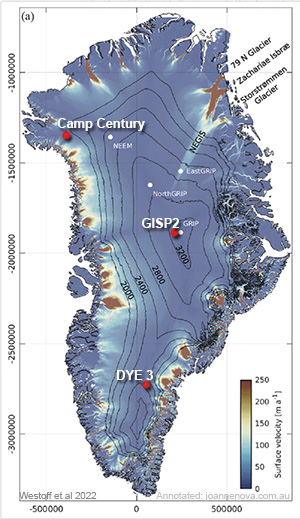 Map adapted from Westoff et al 2022 Finally, 30 years after the famous GISP ice core was hauled out of the Greenland summit, someone has bothered to study the dirt at the bottom and found poppy seeds, willow twigs and insects there, where they were not supposed to be. They discovered a vibrant tundra ecosystem where there was supposed to be an ice-cap. The obvious conclusion is that cavemen didn’t cause it, and that there must be some huge other natural forces at work that we have no clue about. Our climate models didn’t predict this, because CO2 was low then and clearly, the models are hopelessly incomplete. We are babes in the wood on the third rock from the sun. The captive science PR writers don’t tell us that CO2 might be irrelevant compared to the big mystery forces we don’t understand. Instead they tell us that this means that the Greenland icesheet is more fragile than we realized and could melt again (send us your money!) No matter what we discover it’s always worse than we thought:Fossils From The Heart of Greenland Reveal a Greater Threat of Rising SeasScientists have discovered plant and insect remains under a two-mile-deep (three km) ice core extracted from the center of the island, providing the clearest proof yet that nearly all of this vast territory was green within the past million years, when atmospheric carbon levels were much lower than today. Their research, published Monday in the Proceedings of the National Academy of Sciences, indicates even greater potential for global sea level rise due to human-caused climate than previously thought. The stranglehold of government-funded-science meant it took 30 years to do half an hour of research:The ice core, named GISP2, was drilled in 1993 and although its rock and ice had been studied extensively, nobody had thought to look for fossils in the ’till,’ or the mixed sediment at the bottom. That’s because until recently the idea that Greenland was ice-free in the recent geologic past seemed too far-fetched. “Literally, we saw the fossils within the first hour, maybe half hour, of working on it,” lead author Paul Bierman, a professor of environmental science at the University of Vermont, told AFP. To their amazement, researchers found within this three-inch-layer soil willow wood, spores from spikemoss, fungi, the compound eye of an insect, and a poppy seed – together suggesting a vibrant tundra ecosystem. The GISP2 site is about as high and central as you can get in Greenland. If the ice was gone there, it was probably gone everywhere. But the same experts who want us to spend $1,000 billion dollars every year, thought that Greenland was an impenetrable ice-fortress. In 2016 some scientists figured out the bedrock under the GISP core was only 1.1 million years old, which was considered “controversial” since the ice was supposed to have been solid for 2.6 million years. In 2019 Bierman et al were shocked to find that Camp Century (in the far north) had melted totally around 416,000 years ago. (That frozen soil was first dug up in the 1960s, so it sat in a Danish freezer for fifty years.) Another ice core at DYE 3 contained the DNA of spruce trees. Obviously Greenland melts, we just don’t know why, when or how often. The researchers best guess is that the ice melted at the summit probably more than 250,000 years ago and probably less than 1.1 million. Maybe it was 416,000 years ago too. If the whole ice cap melted, the world’s oceans presumably rose the 7 odd meters they are theoretically supposed to rise. There is no denying that this would be seriously inconvenient today, especially for coastal real estate, but it’s also true to say corals reefs didn’t vanish, there was no mass extinction or runaway Greenhouse apocalypse either. The Earth didn’t turn into Venus. The important message here should be that natural climate change could smack us over the head, but we don’t understand the big forces at all. If Greenland’s ice-cap melts again, we need a few decades to prepare. So we need climate models that can actually predict things, not ones that suit politicians and strangle real research for decades. If Greenland melted 416,000 years ago, why didn’t it melt during the other three warm spikes below? (Graph from the EPICA ice core in Antarctica). 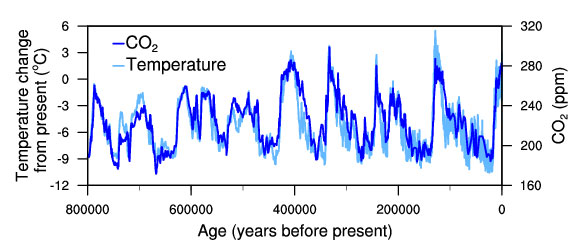 Epica ice core Antarctica. NOAA Photos of the spores, wood and insect eyes that are not supposed to live at the summit of Greenland during an ice age period. 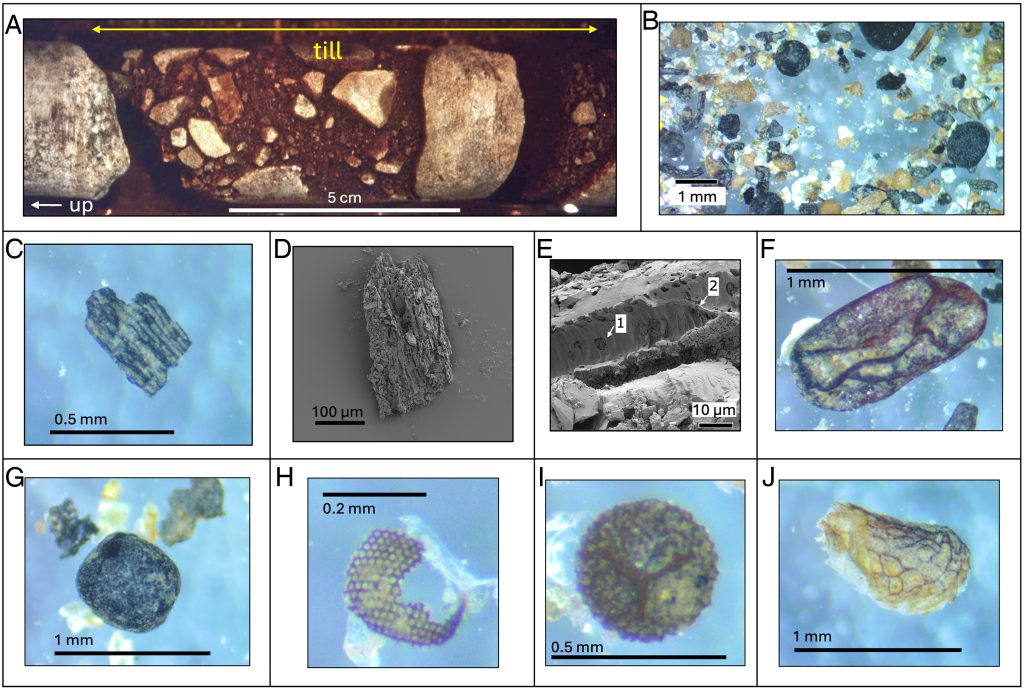 GISP2 till and macrofossils found in it: (A) Photo of the angular-clast-rich till section of the GISP2 subglacial core, taken 1994, up core to left (Credit: T. Gow, supplied by D. Meese). (B) Overview of sediment, mostly quartz and fossils. (C) Wood fragment. (D) Vertical orientation typical of GISP2 wood. (E) Wood at higher magnification showing simple pits in lateral vessel wall (1) and distinct simple perforation plate (2), along with the helical thickening typical of GISP2 wood. (F) Bud scale of Salix (willow). (G) Sclerotium of the soil fungus C. geophilum* (H) Insect eye, possibly from a fly*. (I) S. rupestris megaspore. (J) Seed of Papaver sect. Scapiflora. The asterisk shows macrofossil types also found in Camp Century sediment by ref. 5. Wood fragment images are same specimen. REFERENCEBierman, et al (2024) Plant, insect, and fungi fossils under the center of Greenland’s ice sheet are evidence of ice-free times, PNAS, August 5, 2024, 121 (33) e2407465121, https://doi.org/10.1073/pnas.2407465121 Christ et al (2021) A multimillion-year-old record of Greenland vegetation and glacial history preserved in sediment beneath 1.4 km of ice at Camp Century, PNAS, March 15, 2021, 118 (13) e2021442118, https://doi.org/10.1073/pnas.202144211
By Jo Nova Doubts are spreading about the “prospects of electric cars”Sales of electric vehicles in Germany slumped 37% in July, compared to sales one year ago. It’s not that people don’t want a new car, they just prefer a fossil fueled one. Sales of normal cars rose 7% in the same period. Electric Car Sales Plummet 37% in Germany as Slump DeepensBy Wilfried Eckl-Dorna, Bloomberg “The ramp-up of e-mobility is proving to be unsustainable so far,” Constantin Gall, a consultant at EY, said of the German sales results. “The market has lost all momentum and many customers doubt the prospects of electric cars.” The slowdown leaves the auto industry exposed after investing billions in the ramp-up of the technology. VW, Europe’s biggest automaker, said last week it has cut capacity at high-cost plants in Germany and also might change the timing of its ramp-up in battery production. EV’s made up 20% of new car sales in Germany this time last year, but that market share has now shrunk to 13%. This is not the way a raging new lifesaving technology takes over the planet. In Sweden EV sales are down 15%, and in Switzerland they’re down by 19%. In Australia sales have fallen by about 17% in the last six months. Australians bought about 100,000 cars in July but only 6,700 of them were pure EVs, down from 8,000 earlier this year. Reading these very bitter tea-leaves, Volkswagen has decided to delay the new electric Golf by a year and a half, and keep its old fossil fueled Golf around until 2035. It will now only go out of production when combustion engines are banned in the EU (if that actually happens). This would be but a minor market statistic were it not for the grandiose expectations of Western governments and the billions of dollars taken from the workers in order to help the rich get an electric toy and “better weather”.
Sorry about Wednesday. By Jo Nova It could have been so much worseA Mercedes Benz EV started smoking in an underground carpark in Incheon, South Korea last Thursday at 6:15am. After the immolation, 40 other cars were burnt and another hundred suffered some damage. At least 16 people were taken to hospital for smoke inhalation. Some 48o households lost electricity, and later 121 people had to be relocated. It apparently burned for eight hours. Allegedly, eighty fire engines (or pieces of equipment) turned up with 177 firefighters. Some 209 residents were in the apartment at the time, and “nearly half” were rescued by firefighters from stairs and balconies. The investigation is ongoing… but there are many puzzles. It wasn’t a cheap car, it wasn’t charging and had been sitting in that spot for 59 hours and nothing apparently triggered the blaze. Not surprisingly, there are reports that residents in other Seoul apartment blocks are moving to ban electric vehicles from their basement carparks. EV-phobia spreads, as police investigate cause of electric car explosionThe Nation Incheon police on Tuesday said it is investigating what caused the mysterious explosion of an electric car last week, but some apartment residents in the greater Seoul area are already moving to ban electric vehicles from their underground parking lots. Insurance companies will be watching on warily. Who pays when your car crash destroys 40 cars, and damages another hundred? There are perhaps some clues though: Mercedes-Benz EQE Fire Incident Raises Questions About Chinese EV Battery SafetyMichael Herh, Business Korea According to the Ministry of Land, Infrastructure and Transport and the battery industry, the battery cell of the Mercedes-Benz EQE sedan that caught fire was a product of China’s Farasis. This battery is of the Nickel-Cobalt-Manganese (NCM) type, though the exact model name has not been disclosed. Founded in 2009, Farasis achieved sales of $2.32 billion last year, ranking 10th globally in terms of sales and shipment volume. In 2018, Farasis signed a 10-year battery supply contract with Daimler, the parent company of Mercedes-Benz, and in 2020, Mercedes-Benz acquired about a 3% stake in Farasis to jointly develop batteries. In March 2021, China’s state-owned Beijing Automotive Group (BAIC) recalled 31,963 electric vehicles equipped with Farasis batteries, citing “the possibility of battery fires …” Pick your carpark carefully (and your apartment block.)
By Jo Nova The Crash Test Dummy Nation wins a Gold Medal in Electricity PricesAnd you thought last week was bad. While the single spike at $17,000 a megawatt hour in five states simultaneously was a record, just a week later we have the double spike bonfire — peaking at breakfast and dinner on the same day in our two largest states. That’s a high degree-of-difficulty (to pay the bill). This was not just a 5-minute bid rocket — it was 90 full minutes of blitzkreig twice in a day for both NSW and Victoria. With admirable supporting efforts in burning money in Tasmania and South Australia for breakfast, and then in Queensland, which joined the financial bonfire for dinner. The average price for the whole 24 hour period of August 5th was eye-watering. Last week the spike flattened out to about $300 per megawatt hour across the day. But yesterday in NSW and Victoria, the average price was $2,150 across both states for 24 hours in a row. It’s possible the AEMO will have to take over the market again in some states to put the fire out. Welcome to renewable hellAt both peaks Victoria was burning 7.5GW of power at $17,000 a megawatt hour. In NSW the breakfast peak was 10GW and the dinner peak was 12GW. Count the money… theoretically this is $17 million per gigawatt hour. While the retailers have some hedging to avoid the carnage on the spot market, each spike is sending a price signal that’s about $200 million dollars. We could have built a gas plant…. It would be cruel to say these price spikes correlated with wind and solar failures, but I’ll say it anyway:
Paul McArdle of WattClarity points out demand was 30GW in the evening — which is moderately high, but not a record. Wind was low, clouds rolled in sapping solar power, and seven out of 44 coal plants were out of action (partly by design and partly by accident). It was, of course, another hostile high pressure cell — 5,000 miles wide and here to becalm the entire continental wind power industry. What happens if “Climate change” causes High Pressure Cells over Australia?
And the clouds rolled overAt 8am the grand total of wind and solar power yesterday was only 4 gigawatts. Just a few days ago, at 8am, the same equipment was providing 6.6 gigawatts. So it’s just an “unplanned” outage of 2.5 gigawatts. From the BOM Satellite page Even though the biggest bonfires were in NSW and Victoria, things were bad on the whole National Grid — for the 24 hour period Queensland also averaged $1,040 per megawatt hour, South Australia: $1,600 and Tasmania $943. Days like this will change the quarterly average price. And let’s not forget that if we’d made different choices, a good old brown coal plant could have made all this electricity for $8 a megawatt hour. But who needs money right?
|
||||
|
Copyright © 2024 JoNova - All Rights Reserved |
||||





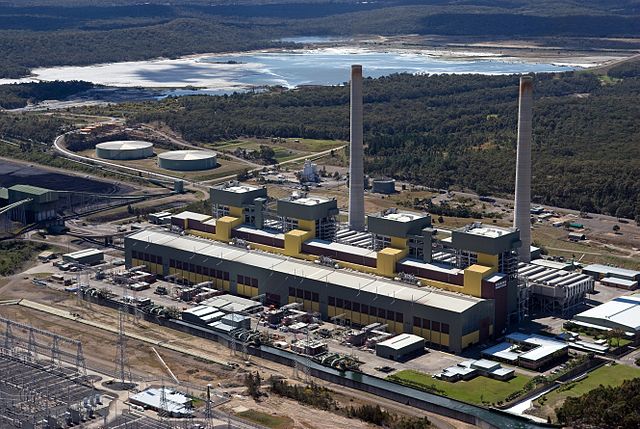
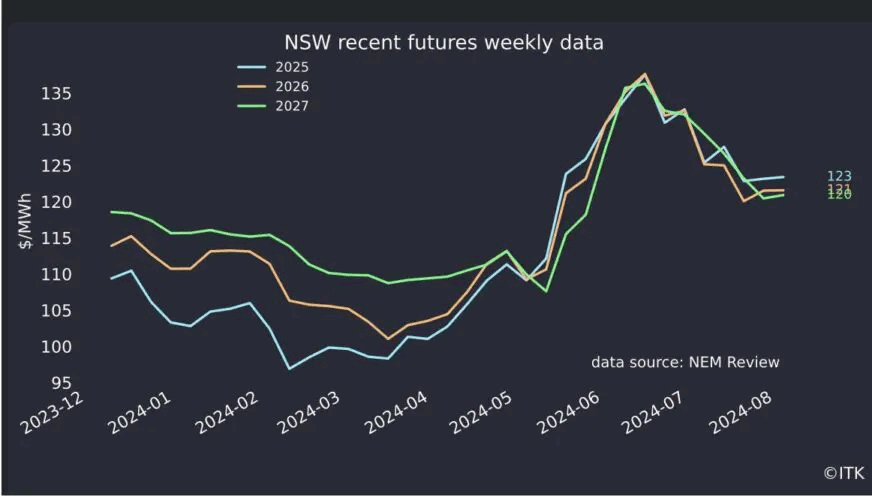


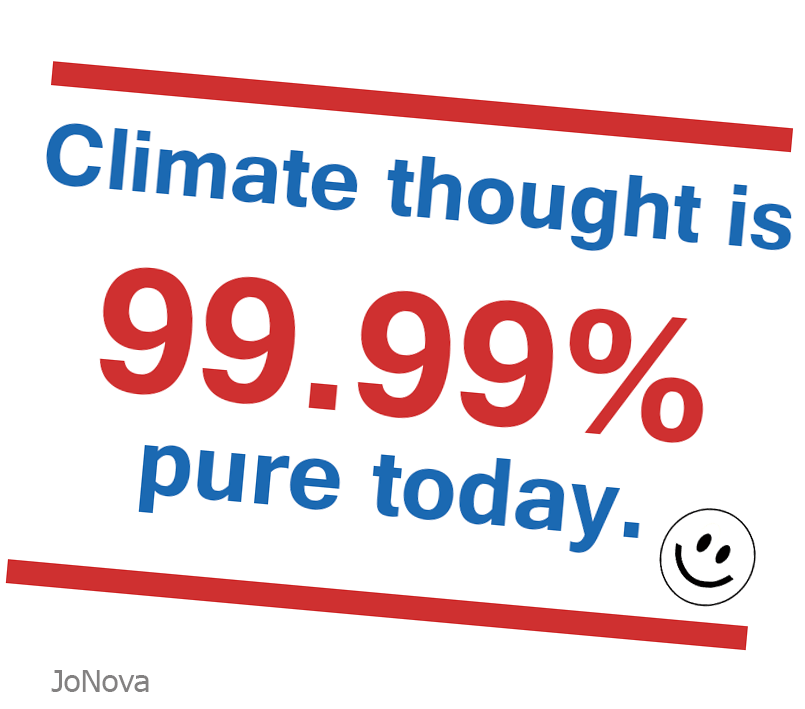
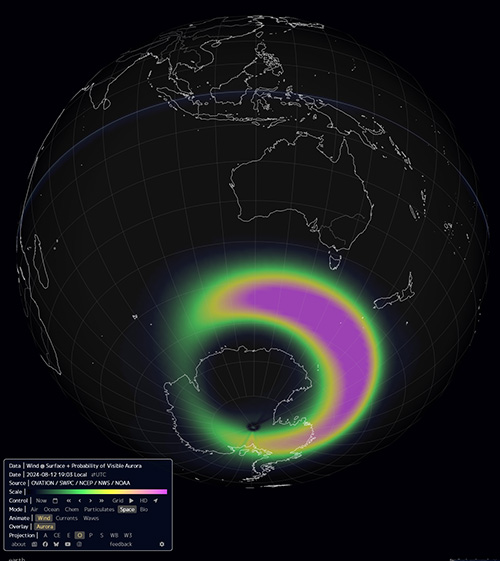


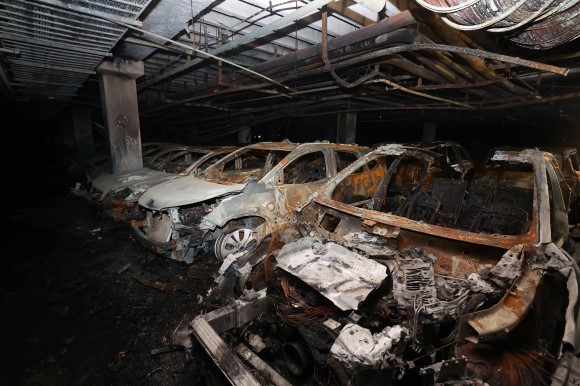

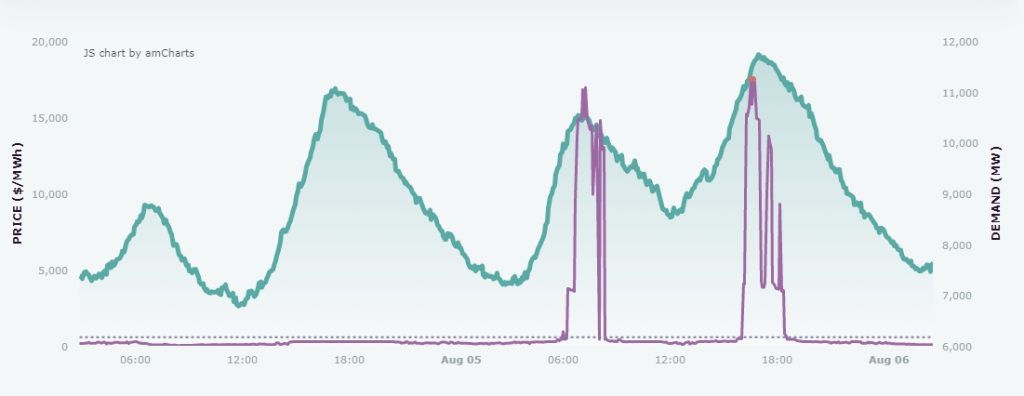
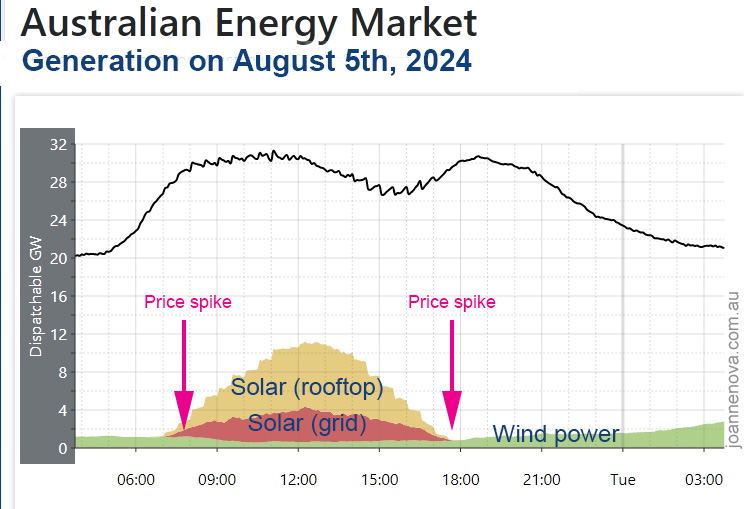
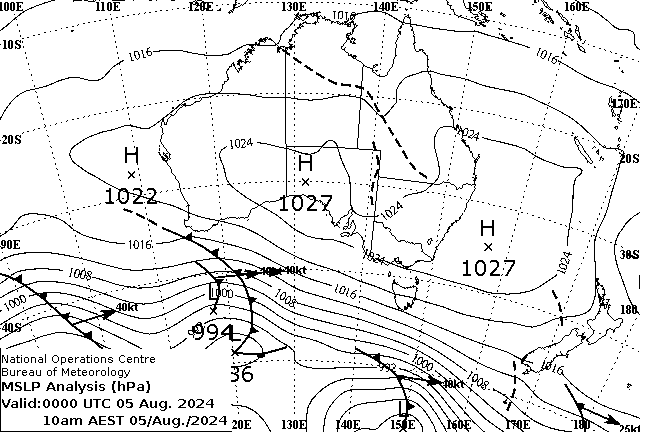
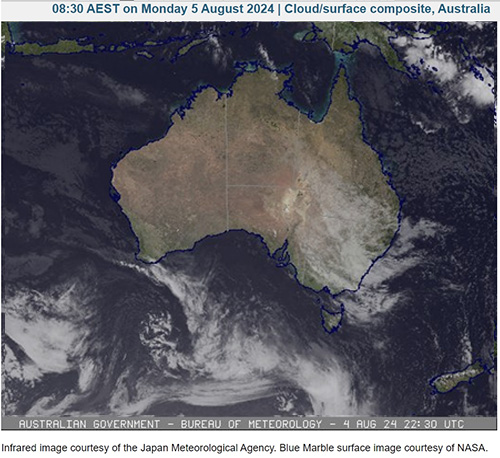
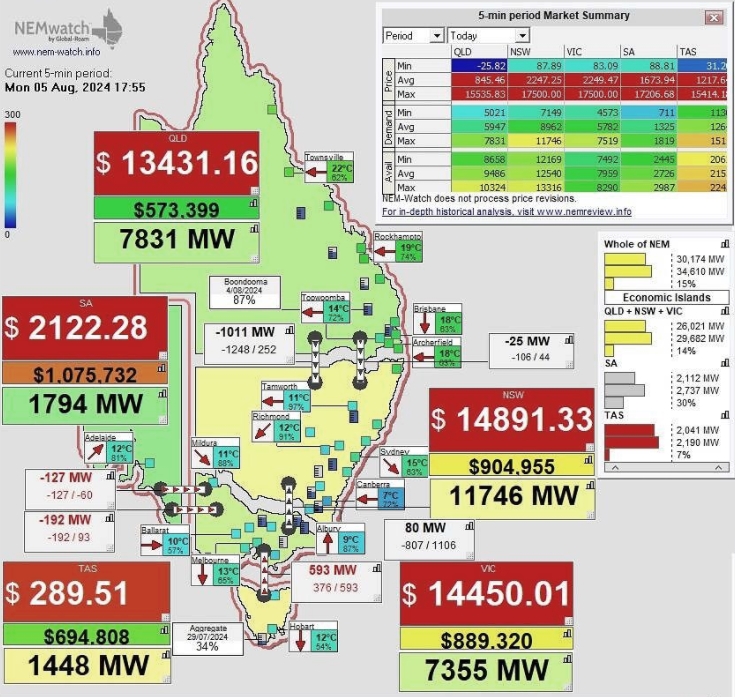











Recent Comments